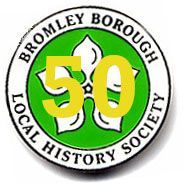Bromley Borough Local History Society
Registered Charity
No. 273 963

BROMLEY BOROUGH LOCAL HISTORY SOCIETY
Around twenty members of BBLHS led by the redoubtable Brian (in a hard hat so that residents could identify him as an official permitted guide) set off around the edge of the site, skirting the main residential area from the car park by Caesar’s Well above Keston Ponds. This was named, said Brian, by past antiquarians who were rediscovering Britain’s Roman heritage; in fact the well and the ponds were ancient gravel pits. He also debunked another myth: the local Victorian archaeologist Flinders Petrie believed circles in the area were the remains of a Neolithic village. Today we know they were the camp of troops who were on the site during the Napoleonic wars!
Just above the most southerly Keston pond are a ditch and bank, possibly an outer layer of fortification to the Holwood Iron-Age fort.
Pausing to use the commemorative seat inside the Holwood Estate near the remains of the Wilberforce Oak.
The Wilberforce Oak where prime minister William Pitt first committed himself to the abolition of slavery has crumbled in recent years and a replacement is now grwoing in its shell.
Although now overgrown, there is a view into the Vale of Kent that Wilberforce mentions in his account of the discussion in 1788.
The first stop in the park was at a rather ramshackle building – due to be refurbished – which covers the remains of a medieval tile kiln, one of only four that have been found in Kent. Tilers were itinerant and would set up in the vicinity of big houses on a site where there was clay, water and wood. The pond next to the kiln building – now a landscape feature for the nearby houses – was once the clay pit. Brian explained that the kiln was only found 50 years ago when trees were cut down.
Oaks, kilns and beautiful landscaped grounds gave way to the highlight of the walk – the great Iron-Age ditches which are a mile around encompassing 44 acres of land and date from around 200 BC. Though little is left of these great earthworks, thanks to Pitt, when we walked along the inner ditch it was clear, even today with the bottom silted up and trees and earthslips making the sides less steep, that this was a formidable defence. Originally reaching overall heights up to 40 feet (12 metres) it was, said Brian, one that even a tank would not be able to negotiate, let alone invading hordes.
The fort was used by a Kentish tribal unit in times of trouble. The farmers, whose farms would have been dotted around the landscape, their cattle and other animals would be brought in for safety when neighbouring tribes invaded. It was rather like an “air raid shelter” said Brian, “and it could have been a tribal headquarters”. But when William Stukley, the pioneering 17th century archaeologist, saw the decayed earthworks he thought it had to have been constructed by the Romans – Caesar’s troops would have had to come through Keston – and named the area Caesar’s Camp, thus causing a lot of confusion ever since!
The walk ended at a grassy path not far from the main Westerham Road, which had once been the main entrance to the hill fort and the site where, if Brian’s plans of 25 years ago had come to fruition, they would have reconstructed part of the fort.
Although the walk did not have any great buildings to visit or significant artifacts to admire, there had been much to see of the grounds, the trees and the beautiful countryside and with Brian’s well-informed and lively narrative, it was easy to see what a mighty construction had once dominated the landscape at Holwood on what was a thorougly enjoyable and fascinating excursion.